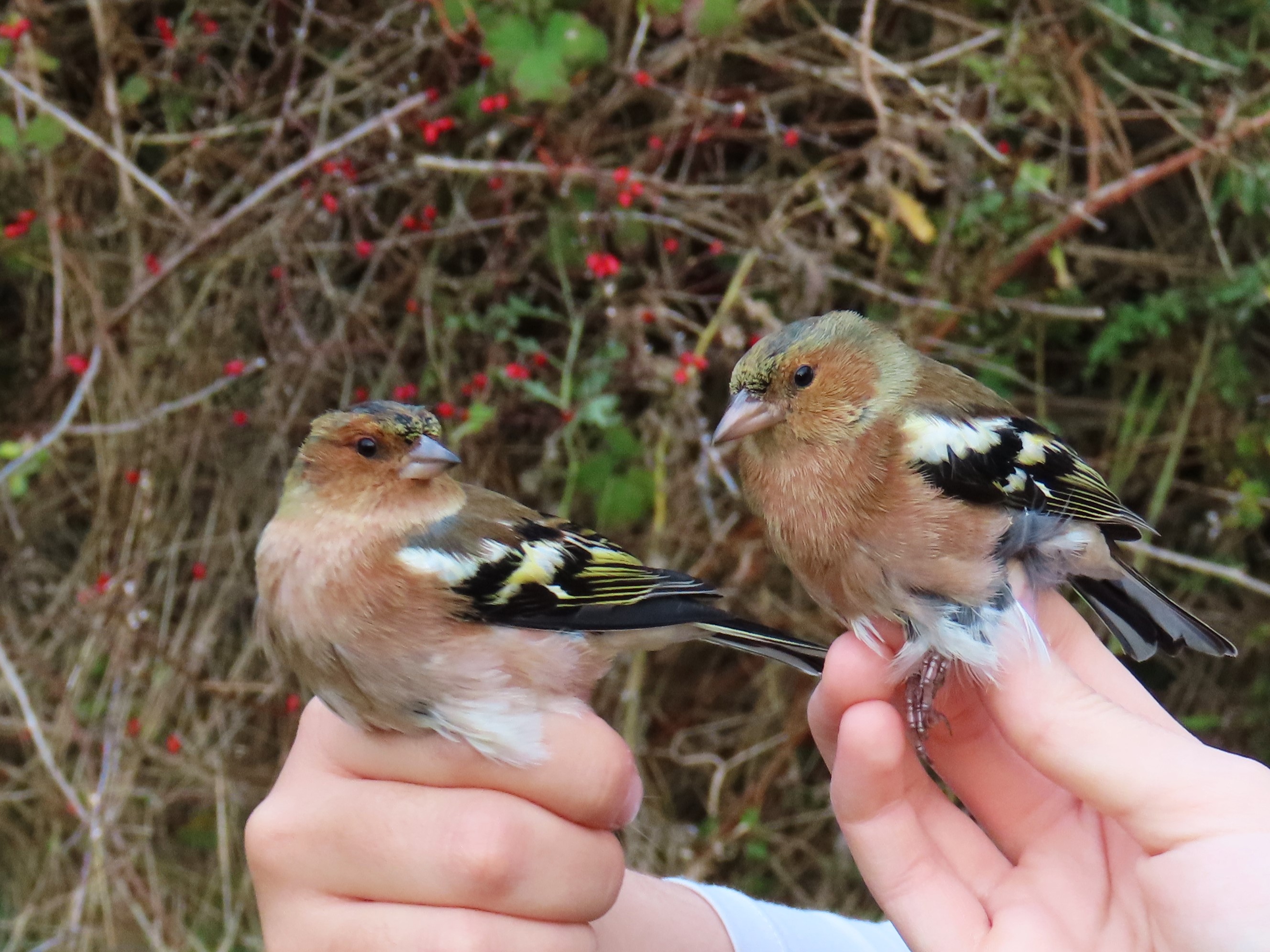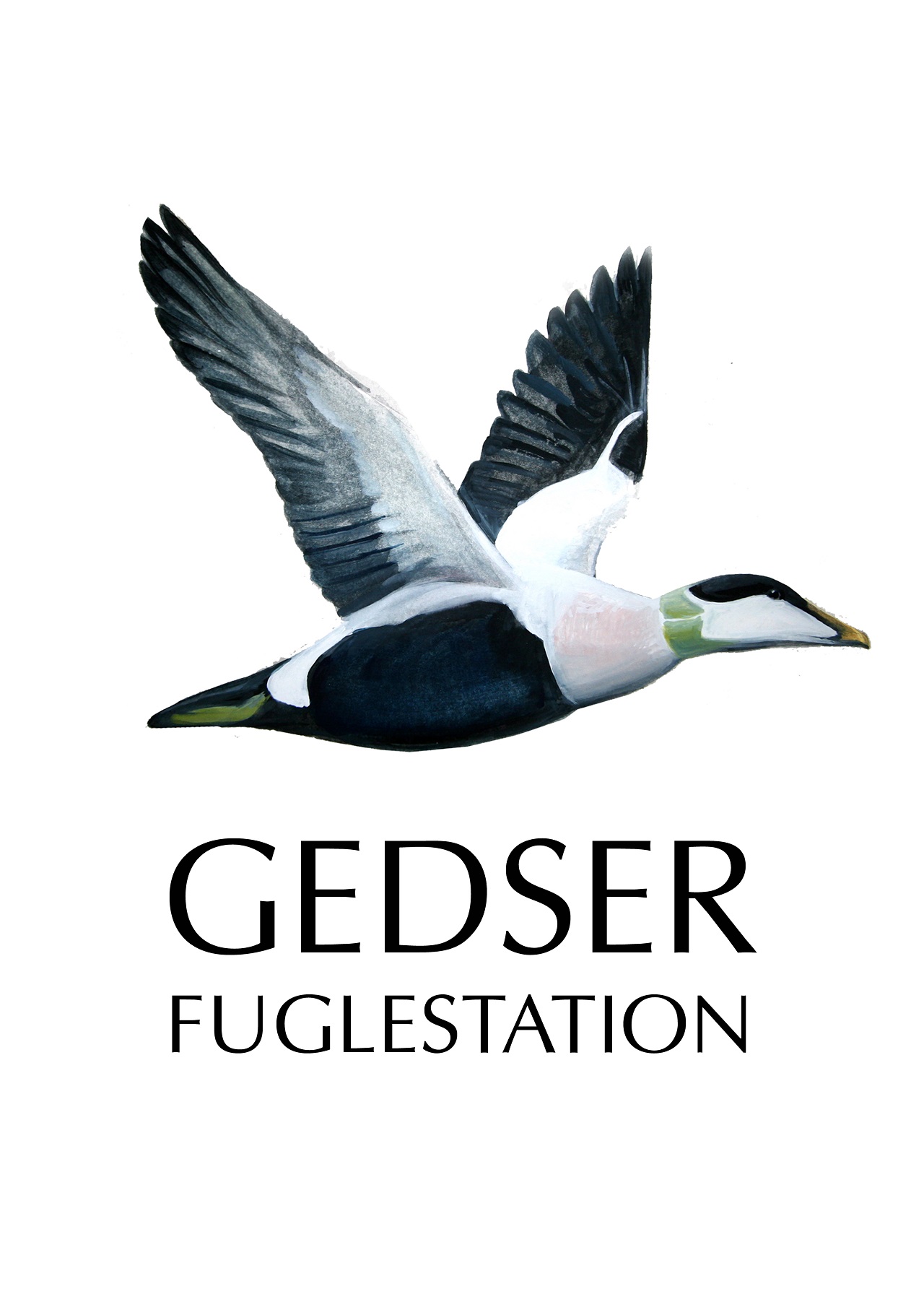Gedser Fuglestation Blog
Her på Gedser Fuglestations blog bringes korte nyheder i dagbogsformat om hændelser på fuglestationen.
The Thrushes are Here
Ringmærkningen: Today, a grand total of... 10 birds! Plus 5 recaptures. Vindrossel/Redwing (Turdus iliacus) teased us today, with a flock flitting through the garden's berry-laden bushes, but just missing our mist nets. We did have two gorgeous male Bogfinke/Chaffinch (Fringilla coelebs) today - one 1K bird and one 2K+ bird. This lead to an educational comparison, with the moult contrast distinctly present in the wing of the 1K bird, and the adult not showing this contrast but instead possessing uniform plumage. It was nice to visualise the differences when ageing this species. I really enjoy handling Chaffinches, as they have a special place in my heart.

Trækket på Odden:
by Lara W
A total of 7,109 birds of 52 species were counted on migration this morning. The morning started with reports from Gedser of large flocks of thrushes passing over the town, so we were hopeful of spotting at least several hundred of these birds migrating past the point. We were not disappointed! Mistle Thrush/Misteldrossel, Redwing/Vindrossel, Fieldfare/Sjagger, and Song Thrush/Sangdrossel were all seen on migration, with a total of 1,337 individuals counted, in both single and mixed-species flocks. Passerine and near-passerine migration in general was good for at least a couple hours of standard time, with 20 species seen, the most abundant of which were Chaffinch/Bogfinke and Brambling/Kvækefinke at 1,235 birds. Several medium-sized flocks of Twite/Bjergirisk were spotted much to our delight, with 63 individuals counted, up by several orders of magnitude from previous days. In addition, 825 Siskin/Grønsisken, 281 Linnet/Tornirisk, and a single late Barn Swallow/Landsvale were counted, among others. Thanks to Benjamin Lisse for keeping his eyes and ears peeled for all the small peep-peeps, as well as doing his level-best to teach me how to identify birds by their flight patterns, grouping, and general movement. I would like to take this opportunity to thank Ben for being a fantastic teacher, birder, and good companion throughout the long hours on the point. If you are reading this Ben, thank you, and good luck with your upcoming university exams!
Raptor migration was much slower than earlier on in the week, with just 19 Sparrowhawk/Spurvehøg and a single Rough-Legged Buzzard/Fjeldvåge making the crossing, although a couple of buzzards were seen hunting around the Fuglestation throughout the course of the morning. The Kestrel/Tårnfalk which has been hunting in the area around the point over much of the last week continued to keep us company, often coming down to earth within 15m of our position. The delicate features and colouring of this bird have always given me pause, the tear-shaped markings, reminiscent of a Cheetah/Gepard, running down from the inner eye corner on either side of the bill; the bill itself – sharply curved, and much more petite than the similar-sized Sparrowhawk’s; the warm reds and browns of the upperparts, paler belly and pantaloons (yes, they are pantaloons, do not try to convince me otherwise!) with their delicate barring, and deep browns and blacks of the primaries all combine to make a truly beautiful looking bird.
Common Kestrel on Gedser Odde, photo credit: Lara Winsloe
The large flocks of Barnacle Goose/Bramgås which are currently taking up residence in the area periodically swept above our heads, venturing a little out to sea before returning inland. We counted 50 of these embarking on migration, although several other geese were also noted flying south: 35 White-fronted Goose/Blisgås, 4 Tundra Bean Goose/Sædgås ssp.rossicus, and 6 Dark-bellied Brent Goose/Knortegås ssp.bernicla. Action on the sea was mainly confined to a couple of hours around the midway point of standard, with 2,318 Common Eider/Ederfugl, 176 Common Scoter/Sortand, and 86 Red-breasted Merganser/Toppet Skallesluger making up the majority. The last few Sandwich Tern/Splitterne appear to be passing, with 4 recorded, although gull migration appears to be picking up in volume, with 29 Common Gull/Stormmåge, 8 Herring Gull/Sølvmåge, 6 Black-headed Gull/Hættemåge, and 7 Little Gull/Dværgmåge recorded. 24 Red-throated Diver/Rødstrubet Lom, 5 Red-necked Grebe/Gråstrubbet Lappedykker, 10 Long-tailed Duck/Havlit and a surprising 13 Razorbill/Alk were also counted, although the appearance on the scene of two adult Gannet/Sule provoked particular interest. One individual remained within sight foraging, for a good half hour, gliding around 25m above the waves before abruptly folding in his wings to plunge downwards like a stone – crashing almost vertically through the waves to emerge, occasionally up to 30 seconds later, with a dramatic breaking of the dark waters around his shockingly white body. Being such a large bird, he was easily visible with the naked eye even several hundred metres out – a real pleasure to witness in his natural environment simply behaving like the wild creature he is.
***
Se alle dagens observationer fra Gedser Odde i DOFbasen.
Folk på stationen: Lara Winsloe, Larissa Britton, Ole Friis Larsen, Anne Hermanns, Birgit Barkholt, Jakob Barkholt, Hans Lind, Susanne Primdahl




